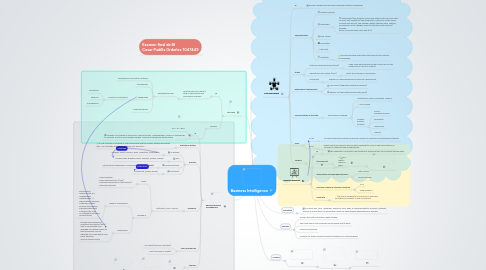
1. Business process management
1.1. is
1.1.1. EIS + BI = BPM
1.1.2. Focuses con strategy & objectives. Uses processes, methodologies, metrics & technology to measure, monitor and manage business financial & operational performance
1.2. difference with BI
1.2.1. BI not focused on strategy it is the technology used to access, analyze and report data. BPM strategy driven. Turn strategy into execution
1.3. process
1.3.1. Strategiza
1.3.1.1. Answers: What? Mission, goals, objectives, incentives
1.3.2. Plan
1.3.2.1. Answer: how? Budgets, plans, forecast, models, targets
1.3.3. Monitor/analysis
1.3.3.1. Performance dashboards, scoreboards, reports & analysis
1.3.4. Act/adjust
1.3.4.1. Collaborate, assess, decide
1.4. produces
1.4.1. Metrics
1.4.1.1. types
1.4.1.1.1. -Sales operation -Service performance (SLAs) -Customer performance (satisfaction) -Sales plan/forecast
1.4.1.2. showed in
1.4.1.2.1. Balance scoreboards
1.4.1.2.2. Dashboards
1.5. can be helped by
1.5.1. Six Sigma (variance reduction)
1.5.2. Lean (focused on waste)
1.6. vendors
1.6.1. .
1.6.1.1. .
1.6.1.1.1. .
2. Interface
2.1. is
2.1.1. how the end user interact with all the analysis and information available
2.1.1.1. displayed through
2.1.1.1.1. geographical information systems
2.1.1.1.2. Scoreboards
2.1.1.1.3. Dashboards
2.1.1.1.4. corporate portals
2.2. vendors
2.2.1. .
3. Examen final de BI Cesar Padilla Ordoñez 1047449
4. Business analytics
4.1. is
4.1.1. the capability of efficiently manipulating & analyzing data from multiple perspectives
4.2. it answers to
4.2.1. ‘who?’ ‘what?’ ‘what if?’ ‘why?’
4.3. Information & knowledge discovery
4.3.1. Data Mining
4.3.2. Search engines
4.4. Decision support & inteligent systems
4.4.1. DSS
4.4.2. Web analytics
4.5. related to
4.5.1. the use of big data (is a collection of data sets so large and complex) to see correlations
5. Data Warehouse
5.1. is:
5.1.1. decision support and provides improved analytical capabilities
5.2. characteristics
5.2.1. subject oriented
5.2.2. integrated
5.2.2.1. data access (the ability to access and extract data from any data source), data federation (the integration of business views across multiple data stores), and change capture (identification, capture, and delivery of the changes made to enterprise data sources) through Extract, transformation and load (ETL)
5.2.3. time variant
5.2.4. nonvolatile
5.2.5. real-time
5.2.6. metadata
5.2.6.1. provide enriching information that leads to the creation of knowledge
5.3. types
5.3.1. Enterprise data warehouse (EDW)
5.3.1.1. large-scale data warehouse that is used across the enterprise for decision support
5.3.2. Operational Data Stores (ODS)
5.3.2.1. short-time storage of information
5.3.3. Data marts
5.3.3.1. subsets of a data warehouse focused on a department
5.4. development approaches
5.4.1. Top-down (integrating enterprise systems)
5.4.2. Bottom-up (with departmental data marts)
5.5. representation of the data
5.5.1. Dimensional modeling
5.5.1.1. snowflake schema
5.5.1.2. star schema
5.5.1.3. creation process (kimball)
5.5.1.3.1. select business process
5.5.1.3.2. granularity
5.5.1.3.3. dimensions
5.5.1.3.4. metrics
5.6. uses:
5.6.1. OLAP
5.6.1.1. To support decision making and provide answers to business and management queries
5.6.2. OLTP
5.6.2.1. To get data from different sources but is different to OLAP in the sense that OLTP focuses on capturing and storaging data
5.7. vendors
5.7.1. .
5.7.1.1. .
5.7.1.1.1. .
6. Definition
6.1. Architectures, tools, databases, analytical tools, apps, & methodologies to recollect, integrate, analysis & presentation of information useful for the business making decision process
7. benefits
7.1. Provide accurate information when needed
7.2. Real-time view of the corporate performance and its parts
7.3. Produce predictions
7.4. Drilldown to details Support business strategy to accomplish goals
8. vendors
8.1. .
8.1.1. .
8.1.1.1. .
